Perpetual Bundle
Can Perpetual Company Thrive in Tomorrow's Financial Landscape?
Perpetual Limited, a cornerstone of the Australian financial services sector since 1886, has consistently adapted its Perpetual SWOT Analysis to navigate the complexities of the market. From its inception, the company has focused on enduring financial stewardship, a principle that continues to guide its growth strategy. This analysis delves into the future prospects of the Perpetual company, examining its evolution and strategic shifts.
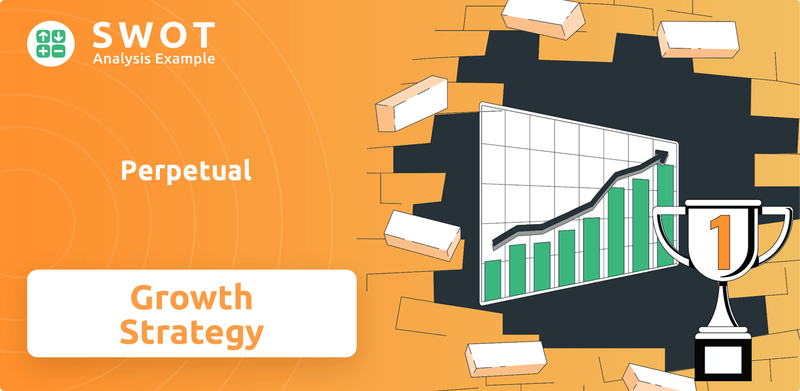
Understanding Perpetual's journey, including its significant acquisition of Pendal Group and its strategic realignment, is crucial for investors and strategists alike. The company's commitment to a business separation program and cost reduction initiatives highlights its focus on business development and strategic planning. This exploration provides insights into how Perpetual aims to leverage its substantial market position to capitalize on emerging opportunities and ensure long-term success, offering a comprehensive view for company valuation.
How Is Perpetual Expanding Its Reach?
The company's expansion strategy centers on strengthening its core businesses and exploring new avenues for growth. This approach follows a strategic review and the termination of a major deal. The primary focus is on the separation of its Asset Management, Wealth Management, and Corporate Trust businesses.
A key element of this strategy involves the proposed sale of the Wealth Management business. The proceeds from this sale are earmarked to bolster the Group's capital position. These funds will support investments in organic growth within Corporate Trust and Asset Management.
The company's commitment to organic growth and strategic initiatives highlights its focus on long-term value creation. This approach aims to enhance its market position and capitalize on emerging opportunities. The goal is to achieve sustainable growth across all its core business segments.
The Asset Management division is implementing a new strategy focused on simplification, operational excellence, and organic growth. This includes scaling its international distribution capabilities. The goal is to support new product launches in target markets and rebalance distribution resources across regions.
A significant focus for institutional distribution is Asia, which represents approximately 20% of global assets under management (AUM). The company currently has limited exposure in this region. The company aims to diversify its client base across intermediary and institutional channels.
The company plans to increase capabilities and product offerings for the intermediary market in the US. This includes developing a holistic ETF strategy. Barrow Hanley, a part of the company, delivered net inflows, particularly from global and international capabilities.
Corporate Trust is pursuing organic growth, supported by new client wins in its securitization reporting business. The digital business within Corporate Trust, Perpetual Digital, has also reported organic growth. The company is attracting new clients for its Data Services product.
The company's growth strategy includes specific initiatives and achievements across its business segments. These efforts are aimed at enhancing its market position and driving sustainable growth. The recent data reflects the company's commitment to its strategic goals.
- Barrow Hanley attracted approximately $2.5 billion in net inflows in the first half of FY24.
- Perpetual Digital attracted new clients, including two large non-bank clients and one bank client for its Data Services product by December 31, 2024.
- Wealth Management has seen strong organic growth, particularly in the pre-retiree segment, the Fordham accounting practice, and the medical and aged care segments.
- The company is focused on analyzing the competitive landscape to refine its growth strategy.
Perpetual SWOT Analysis
- Complete SWOT Breakdown
- Fully Customizable
- Editable in Excel & Word
- Professional Formatting
- Investor-Ready Format
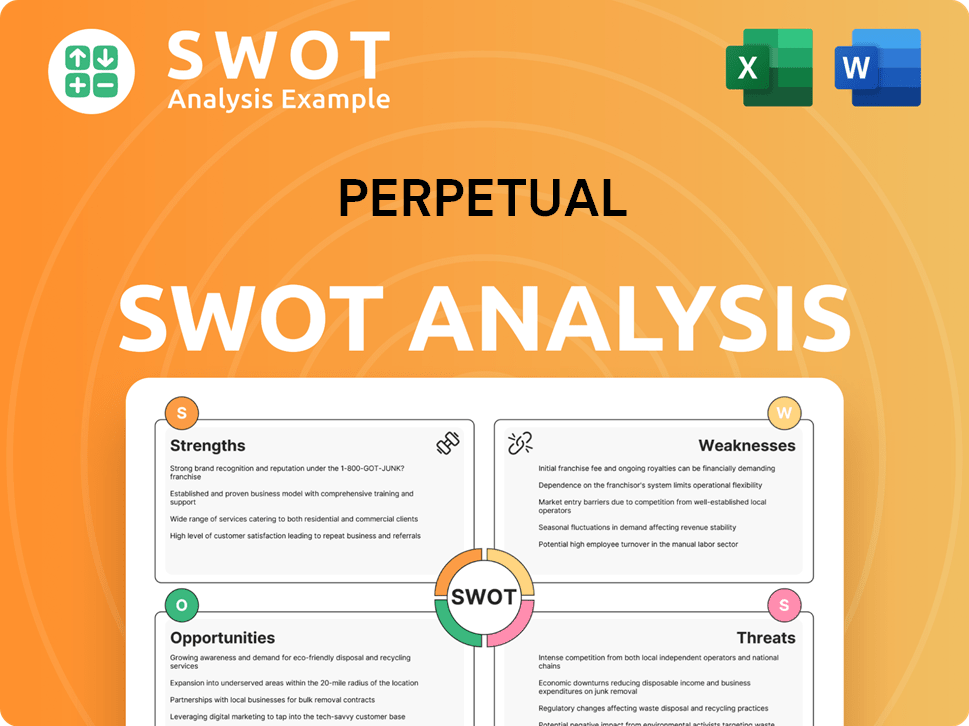
How Does Perpetual Invest in Innovation?
The company heavily relies on technology and innovation to drive its growth strategy, especially within its Corporate Trust division. This focus is exemplified by Perpetual Digital, which was recognized as one of Australia's most innovative companies in 2024 by the Australian Financial Review. This recognition underscores the company's commitment to digital transformation and its proactive approach to addressing the evolving needs of the financial sector.
The company's approach to digital transformation involves moving clients from manual processes and spreadsheets to cloud-based, Platform-as-a-Service solutions that are integrated, evergreen, and scalable. This shift aims to improve efficiency, reduce operational risks, and enhance the overall client experience. The company's investment in technology is a key component of its strategic planning and business development efforts.
The company's commitment to innovation extends to its investment management and risk teams, where platforms like Affinity are being used to access climate-related data. This supports investment oversight and helps identify emerging climate-related risks within portfolios. This proactive approach to integrating environmental, social, and governance (ESG) factors into investment decisions demonstrates a forward-thinking approach to strategic planning.
Perpetual Digital is at the forefront of digital transformation in the fixed income market. It provides solutions to the banking and financial services sector, addressing challenges like regulatory change and cyber threats.
Launched in collaboration with BondAdviser, this platform allows fixed income investors to purchase global securities in smaller parcels. This platform broadens market accessibility for a wider range of investors and advisors.
The company continuously invests in its systems, governance, processes, and people to support its growth strategy. This includes ongoing development and launch of platforms like Fixed Income Intelligence.
The Affinity platform is being trialled by investment management and risk teams to access climate-related data. This supports investment oversight and helps identify climate-related risks.
The Fixed Income Intelligence platform enables fixed income investors to purchase global securities in smaller parcels, as low as $10,000. This expands market access for a wider range of investors.
Technological advancements aim to enhance efficiency and reduce risk. This contributes to the company's overall growth strategy and objectives.
The company's technological initiatives are designed to enhance efficiency, reduce risk, and support the future prospects of the company. This includes the development of platforms and the integration of new technologies to improve operations. For more context, you can read about Brief History of Perpetual.
- Fixed Income Intelligence Platform: This platform facilitates easier trading and portfolio management for fixed income investors.
- Cloud-Based Solutions: Transitioning to cloud-based, Platform-as-a-Service solutions enhances scalability and integration.
- Climate Data Integration: Using platforms like Affinity to access climate-related data supports investment oversight and risk management.
- Continuous Investment: Ongoing investment in systems, governance, processes, and people ensures sustained technological advancement.
Perpetual PESTLE Analysis
- Covers All 6 PESTLE Categories
- No Research Needed – Save Hours of Work
- Built by Experts, Trusted by Consultants
- Instant Download, Ready to Use
- 100% Editable, Fully Customizable
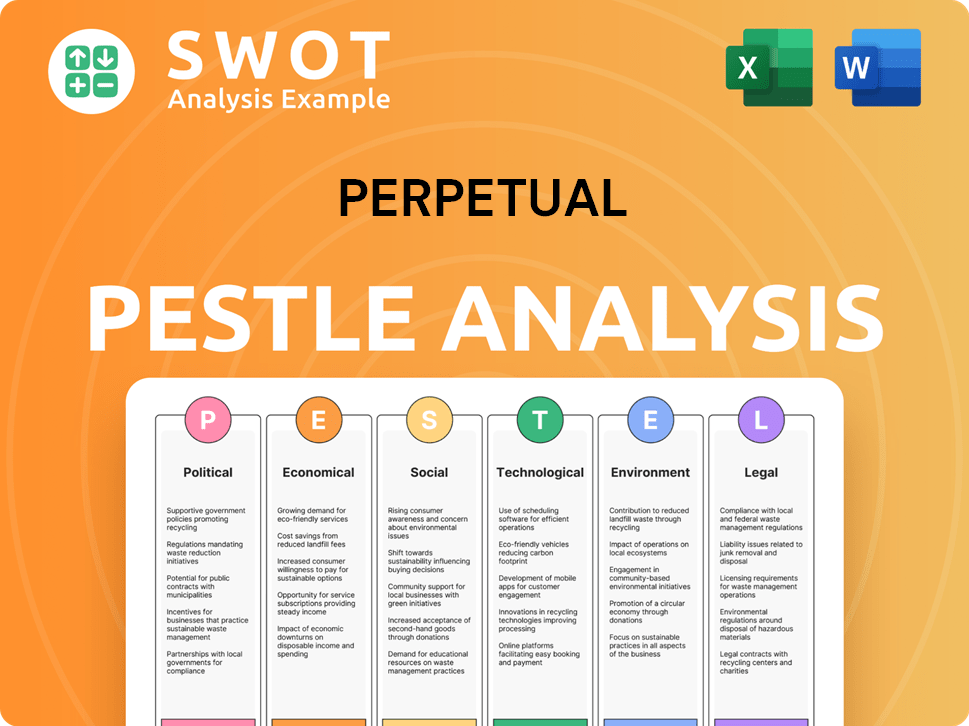
What Is Perpetual’s Growth Forecast?
The financial outlook for the company in 2025 and beyond is significantly influenced by its strategic restructuring and ongoing efforts to enhance performance across its business segments. The company's focus includes debt reduction and cost optimization through its Simplification Program. These initiatives are designed to strengthen the company's financial position and support sustainable growth.
For the half-year ending December 31, 2024 (1H25), the company reported an underlying profit after tax (UPAT) of A$100.5 million, marking a 2% increase compared to the previous year. This growth was driven by higher Assets Under Management (AUM) in Asset Management and continued growth in Wealth Management and Corporate Trust businesses. However, the statutory net profit after tax (NPAT) for 1H25 was A$12.0 million, significantly lower than A$34.5 million in 1H24, primarily due to significant items related to the strategic review and other factors.
The company's total operating revenue for 1H25 was A$686.2 million, an increase of 4% compared to 1H24. The proposed sale of the Wealth Management business is expected to strengthen the Group's capital position over the longer term, aligning with its long-term strategic goals and Owners & Shareholders of Perpetual.
Asset Management's underlying profit before tax (UPBT) increased by 7% to A$102.6 million, with revenue of A$455.0 million, up 4% on 1H24. This growth demonstrates the effectiveness of the growth strategy in this segment.
Wealth Management's UPBT grew by 12% to A$29.2 million, and Corporate Trust's UPBT rose by 8% to A$44.0 million. These segments show strong performance and contribute to the overall future prospects.
The company is focused on debt reduction, aiming to decrease gross debt from A$840 million at December 31, 2024, to approximately A$740-A$750 million by June 30, 2025. This strategic planning will improve the company's financial stability.
The Simplification Program aims to deliver annualised cost reductions of between A$70 million and A$80 million, before tax, by FY27. Approximately A$10 million in annualised cost reductions were delivered in 1H25, with a forecast of A$30 million by the end of FY25.
The company's future prospects are tied to successful execution of its strategic initiatives. These include debt reduction, cost optimization, and potential divestments. The company's focus on streamlining operations and enhancing profitability positions it for sustainable growth.
- Growth strategy implementation steps for a perpetual company.
- Long-term financial planning for perpetual companies.
- How to analyze the future prospects of a company.
- Key performance indicators for growth strategy.
Perpetual Business Model Canvas
- Complete 9-Block Business Model Canvas
- Effortlessly Communicate Your Business Strategy
- Investor-Ready BMC Format
- 100% Editable and Customizable
- Clear and Structured Layout
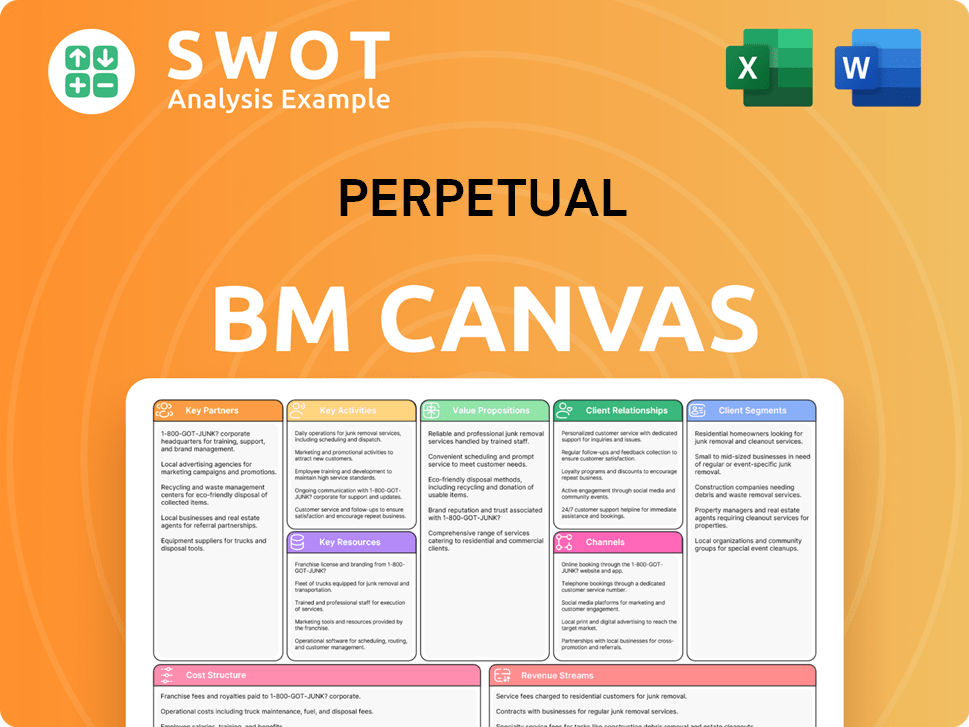
What Risks Could Slow Perpetual’s Growth?
The Perpetual company faces several potential risks and obstacles as it pursues its growth strategy and aims for positive future prospects. These challenges span market dynamics, regulatory changes, and technological disruptions, all of which could impact the company's performance and strategic goals. Understanding these risks is crucial for assessing the company's long-term sustainability and investment potential.
Market competition and operational inefficiencies are significant hurdles for Perpetual. The company must navigate a competitive landscape while managing its resources effectively. These factors can influence the company's ability to achieve its strategic objectives and maintain its market position.
Regulatory changes and technological advancements also pose considerable risks. The financial services industry is subject to evolving regulations, and the rapid pace of technological change requires continuous adaptation. These external factors can impact the company's operations, compliance costs, and ability to innovate.
The company experienced net outflows in certain global, international, and US equity strategies, totaling A$3.4 billion in 1H25, impacting its overall financial performance. Persistent net outflows and fee compression remain significant concerns in the asset management business. These challenges necessitate strategic responses to maintain and improve profitability.
The percentage of strategies outperforming their benchmark decreased from 89% in 2022 to 63% by the end of 2024. This decline indicates potential issues in investment strategies or market conditions. Monitoring and adapting investment approaches are crucial for maintaining competitive performance.
Evolving regulations in the financial services industry pose compliance challenges, especially with cross-border investments and new digital solutions. Staying compliant and adapting to new regulatory requirements is essential for operational continuity and market access. The company must proactively manage these regulatory risks.
The rapid pace of technological advancements, particularly in AI and automation, presents both opportunities and threats. Internal resource constraints, such as a shortage of in-house expertise in managing complex cloud-native systems, could hinder innovation and efficiency. Addressing these technological challenges is critical for the company's future prospects.
Supply chain vulnerabilities can indirectly impact financial institutions through disruptions to technology providers or other third-party services. While not explicitly detailed for Perpetual, these broader risks require ongoing monitoring and mitigation strategies. Diversifying dependencies can reduce these risks.
Geopolitical uncertainties and broader economic shifts, such as potential changes in US fiscal and trade policies under a new administration, present risks. The company must monitor these external factors and adapt its strategies accordingly. External factors can significantly impact the company's financial performance and strategic planning.
The business separation program and simplification initiatives aim to create more focused and autonomous businesses, potentially reducing complexity and improving operational efficiency. Cost reduction targets, with a goal of A$70-A$80 million in annualised savings by FY27, are a direct response to margin pressures, demonstrating a commitment to operational efficiency and profitability. The strategic review and the decision to pursue the sale of Wealth Management are part of a broader effort to optimize the portfolio and strengthen the Group's capital position. These measures demonstrate proactive steps to address challenges and improve the company's financial health.
Embracing digital transformation and investing in internal expertise are crucial for navigating technological disruptions. Proactive adaptation to regulatory changes and investment in innovative solutions are essential for maintaining a competitive edge. Continuous improvement and innovation are key to long-term success. To learn more about how to develop a successful plan, you can read about the Marketing Strategy of Perpetual.
Perpetual Porter's Five Forces Analysis
- Covers All 5 Competitive Forces in Detail
- Structured for Consultants, Students, and Founders
- 100% Editable in Microsoft Word & Excel
- Instant Digital Download – Use Immediately
- Compatible with Mac & PC – Fully Unlocked
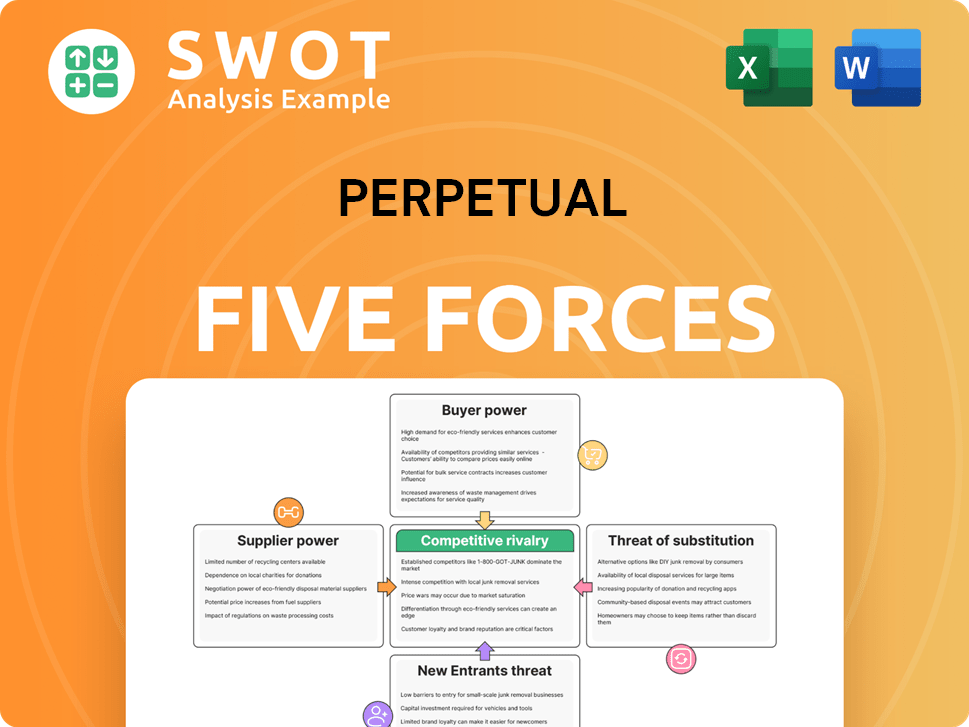
Related Blogs
- What are Mission Vision & Core Values of Perpetual Company?
- What is Competitive Landscape of Perpetual Company?
- How Does Perpetual Company Work?
- What is Sales and Marketing Strategy of Perpetual Company?
- What is Brief History of Perpetual Company?
- Who Owns Perpetual Company?
- What is Customer Demographics and Target Market of Perpetual Company?
Disclaimer
All information, articles, and product details provided on this website are for general informational and educational purposes only. We do not claim any ownership over, nor do we intend to infringe upon, any trademarks, copyrights, logos, brand names, or other intellectual property mentioned or depicted on this site. Such intellectual property remains the property of its respective owners, and any references here are made solely for identification or informational purposes, without implying any affiliation, endorsement, or partnership.
We make no representations or warranties, express or implied, regarding the accuracy, completeness, or suitability of any content or products presented. Nothing on this website should be construed as legal, tax, investment, financial, medical, or other professional advice. In addition, no part of this site—including articles or product references—constitutes a solicitation, recommendation, endorsement, advertisement, or offer to buy or sell any securities, franchises, or other financial instruments, particularly in jurisdictions where such activity would be unlawful.
All content is of a general nature and may not address the specific circumstances of any individual or entity. It is not a substitute for professional advice or services. Any actions you take based on the information provided here are strictly at your own risk. You accept full responsibility for any decisions or outcomes arising from your use of this website and agree to release us from any liability in connection with your use of, or reliance upon, the content or products found herein.